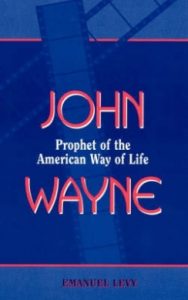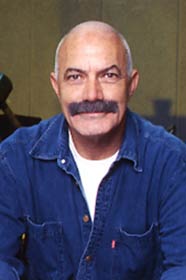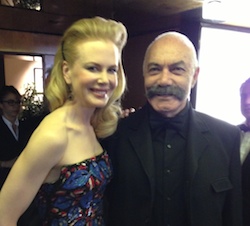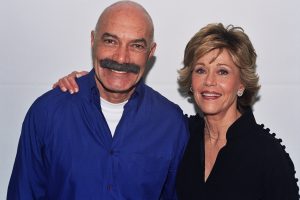Quiz: Which of the 160 feature films thar John (The Duke) Wayne made was his worst picture?
I vote for The Conqueror.

Howard Hughes funded The Conqueror, an epic film featuring John Wayne as Mongolian chieftain Genghis Khan and the redheaded Susan Hayward as a Tatar princess.
The film made the ten-worst list in The Book of Lists, appears in Michael Sauter’s The Worst Movies of All Time, and was among those listed in The Fifty Worst Films of All Time. Additionally, the Aldergrove Star described The Conqueror as the worst ever made and Complex listed it as the worst biopic ever made.
The Guardian called the choice of Wayne for Khan – a role originally written for Marlon Brando – “one of the worst casting decisions of all time”.
Wayne lamented taking the role, stating, “Don’t make an ass of yourself trying to play parts you are not suited for.”
The Daily Telegraph writes: “by absolutely every conceivable metric – financially, critically, historically, ethnically, and even body count – it would come to be known as one of the biggest disasters in cinematic history.”
Hughes, one of the world’s wealthiest people at the time, had previously produced several successful dramatic films, such as Hell’s Angels, Scarface, and The Outlaw.
After viewing The Conqueror, Hughes bought every existing print for $12 million and refused to let the film be seen on TV until 1974, reportedly out of guilt over the decision to shoot at such a hazardous location.
This was the last film Hughes produced.
Grade: F
In Howard Hughes’ production, The Conqueror, directed by Dick Powell, John Wayne was (mis)cast as Genghis Khan, the thirteenth century Mongol Emperor.
| The Conqueror | |
|---|---|

Theatrical release poster
|
|
The plot is rather simple: Mongol chief Temujin (later to be known as Genghis Khan) falls for Bortai, the daughter of the Tartar leader. When he steals her away, it leads to ferocious war. At first, Bortai spurns Temujin and she is taken back in a raid. But after Temujin is captured, Bortai falls in love with him and helps him escape. Temujin suspects he was betrayed by a fellow Mongol and sets out to find the traitor and to overcome the Tartars.
The Duke later said that he had accepted the role without much excitement and out of obligation to his friend Hughes, head of RKO, who had great hopes for the movie.
Note:
If you want to know more about John Wayne’s career and life, please read my book:

This time, however, both reviewers and audiences had difficulties disassociating John Wayne from his American image, and the picture was a financial fiasco.
Critical Response
The Conqueror was described by A. H. Weiler in the New York Times (March 31, 1956) as an “Oriental Western,” and John Wayne’s appearance as “a mite startling at first, but soon recognizable.” “Once in the saddle,” he wrote, “He is the rough riding John Wayne of yore.”
Similarly, the Time magazine critic (August 9, 1956) noted, that the film suggested that “Mongolia is in the Western U.S.,” and that the part of “the Perfect Warrior,” was played by “Hollywood’s best-known cowboy, John Wayne.”
Wayne’s worst dialogue with a woman is in this picture with his co-star Susan Hayward, as a Tartar princess, who’s acquired by him after he had slayed her husband.
Throughout the film he is tough on her, which she resents. Then in a supposedly lusty scene, he tells her father, the ruler Kumlek: “While I live, while my blood runs hot, your daughter is not safe in her tent!” After he is warned, “there is no limit to her perfidy,” Wayne responds, “She is a woman. Much woman. Should her perfidy be less than that of other women.”
Hayward’s Bortai tries to decapitate him with a sword while his back is turned, but he looks into her defiant face and delivers his favorite line, “You’re beautiful in your wrath.”
He then carries her into the tent and tells her, “I shall keep you, Bortai, in response to my passion. Your hatred will kindle into love.” But she is still defiant, “Before that day dawns, Mongol, the vultures will have feasted on your heart.”
More than embarrassing, the love scenes are laughable. They do not even qualify as camp.
To think that Susan Hayward agreed to appear in this film and recite those lines, when she was at the peak of her popularity, is hard to believe. In the same year, she earned raves and Oscar nod for her performance in I’ll Cry Tomorrow, and two years later, she scored big with an Oscar winning tole in I Want o Live!
Wayne himself attributed the film’s failure to his being miscast: “people wouldn’t accept me as Genghis Khan. I’ve been extolled as rough American personality, and the viewers won’t take anything else.” He also revealed that he had interpreted the role of Genghis Khan as a cowboy in the Wild West, and that’s he played him accordingly.
The Conqueror has been chosen as one of “The 50 Worst Films of All Time,” in a popular book edited by Medved and Dreyfuss. They wrote: Made as a Western, ‘The Conqueror’ looks as if the wrong costumes were delivered and they decided to shoot it anyway.”
John Wayne as Genghis Khan is like Mickey Rooney as Jesus in The King of Kings
Jack Smith wrote in the L.A. Times (September 15, 1980) after watching that movie, it would definitely be on his list of the ten, not fifty, worst movies. “I can’t think of a more improbable piece of casting,” he continued, “unless Mickey Rooney were to play Jesus in The King of Kings.”
In later years, Wayne became embarrassed at the slight mentioning of The Conqueror, wishing to forget all about it.
Fortunately for Wayne–and his fans–Hughes was sentimental toward the movie as it was his very last production at RKO. When the studio was sold, Hughes bought back The Conqueror for a phenomenal(undisclosed) amount of money and locked it in a vault until his death; the movie was first shown on American television as late as 1980.
Did the Movie Kill Half of Crew and Cast?
The movie was shot near St. George, Utah, downwind from a nuclear testing range in Nevada, and is often blamed for the cancer deaths of many of the cast and crew, including Hayward, Wayne, Agnes Moorehead, Pedro Armendáriz, and director Dick Powell.
By 1980, 91 of the 220 (over 41%) cast and crew members had been diagnosed with cancer.
In addition to filming near the testing range, truckloads of the red sands were transported back to the studios for the interior scenes.
Cast
John Wayne as Temujin, later Genghis Khan
Susan Hayward as Bortai
Pedro Armendáriz as Jamuga
Agnes Moorehead as Hunlun
Thomas Gomez as Wang Khan
John Hoyt as Shaman
William Conrad as Kasar
Ted de Corsia as Kumlek
Leslie Bradley as Targutai
Lee Van Cleef as Chepei
Peter Mamakos as Bogurchi
Leo Gordon as Tartar Captain
Richard Loo as Captain of Wang’s guard
Credits:
Directed by Dick Powell
Produced by Howard Hughes, Dick Powell
Written by Oscar Millard
Music by Victor Young
Cinematography Joseph LaShelle
Edited by Stuart Gilmore
Production and distribution company: RKO Radio Pictures
Release date: February 2, 1956 (Premiere-London); February 22, 1956 (Premiere-Los Angeles); March 28, 1956 (US)
Running time: 111 minutes
Budget $6 million
Box office $9 million










